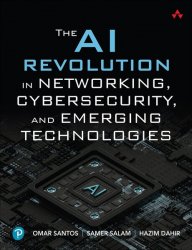 Название
Название: The AI Revolution in Networking, Cybersecurity, and Emerging Technologies (Final)
Автор: Omar Santos, Samer Salam, Hazim Dahir
Издательство: Addison-Wesley Professional/Pearson Education
Год: 2024
Страниц: 221
Язык: английский
Формат: pdf (true), epub (true)
Размер: 10.6 MB
The AI Revolution is Here. Discover its Dynamic Applications in Networking, Cybersecurity, and More. AI is having a profound impact on nearly every sector of the workforce. Huge professional and financial opportunities await in the key domains of computer networking, cybersecurity, IoT, and cloud computing. The AI Revolution in Networking, Cybersecurity, and Emerging Technologies will give you the edge you need to harness AI for your benefit. Learn how AI can efficiently identify shadow data, fortify security measures, generate predictive analytics in real time, and so much more. In this comprehensive guide, Cisco professionals Omar Santos, Samer Salam, and Hazim Dahir engage you in both AI application and theory through practical case studies and predictions of future trends, which makes this book not just a valuable guide for today, but an indispensable resource for tomorrow. You'll discover how AI is building robust bridges in collaboration tools and turning IoT into a super-intelligent network of devices so you can quickly identify and resolve network security threats while enhancing network performance.